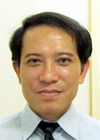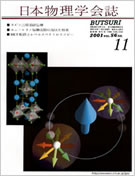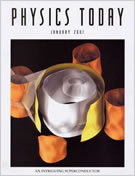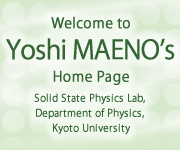Yoshi MAENO's Profile
Introduction

Main Research Activities
The main research interest of my group at present is in the ruthenate physics.These are oxide materials with the same crystal structure as the cuprates (i.e. the well-known high-Tc superconductors). In 1994, we discovered superconductivity in the ruthenate Sr2RuO4 and since then we have developed a highly collaborative world-wide program of research on these materials.
Ruthenate superconductivity is now believed to result from a revolutionary "spin-triplet" state, in which not only the electronic charges but also the active spins of electrons become superfluid. The novel physics of spin-triplet superconductivity has actively been pursued. We specialise in growing high-quality crystals and investigate their physical properties by specific-heat measurements, etc.
Our other main interests include oxide materials with geometrically frustrated spins. Using our own high-quality crystals, we have investigated their unusual physical properties, such as spin-ice and Kagome-ice states. The aims of investigating these materials are to search for superconductivity based on unconventional features and for a quantum spin-liquid state in which electrons spins in an insulator form coherent pairs.
(1) Spin-Triplet Superconductivity in the Ruthenate
These oxide materials have the same crystal structure as the cuprates (i.e. the well-known high-Tc superconductors). In 1994, we discovered superconductivity in the ruthenate Sr2RuO4 and since then we have developed a highly collaborative world-wide program of research on these materials.
Ruthenate superconductivity is now believed to result from a revolutionary "spin-triplet" state, in which not only the electronic charges but also the active spins of electrons become superfluid.
All the conventional superconductors and even the high-temperature superconductors of copper oxides are "spin-singlet" superconductors, in which electrons pair up with their spins antiparallel to each other. (Spin is a quantum-mechanical propertiy of an electron, corresponding to the classical concept of rotaion about its own axis, or spinning.)
Sr2RuO4 is probably the first example of a spin-triplet superconductor for which details of its pairing state based on its entire electronic structure are nearly understood.
We also actively pursue the novel physics of spin-triplet superconductivity. We grow extremely high quality crystals and investigate their physical properties using various techniques including specific-heat measurements; thereby exploring new superconducting phenomena specific to spin-triplet pairing.

Cover page of the November 2001 issue of "Butsuri", a journal from the Physical Society of Japan.
The central figure depicts the electron pair of the spin-triplet superconductivity in Sr2RuO4. Small arrows represnt electron spins; a large arrow represents orbital moment of a pair. From the article "Physics of Spin-Triplet Superconductivity" (Y. Maeno and K. Deguchi).

Cover page of the January 2001 issue of "Physics Today", a journal from the American Physical Society.
The Fermi surface of Sr2RuO4 based on the quantum oscillation experiments. It consists of three nearly-cylindrical sheets. Courtesy of Dr. C. Bergemann. From the article "The Intriguing Superconductivity of Strontium Ruthenate"(Y. Maeno, T.M. Rice, and M. Sigrist).
(2) Metal-Insulator Transition in Strongly Correlated Electron Systems
Strongly correlated electron systems are materials in which interaction among the electrons due to Coulomb repulsion plays a dominant role in determining the physical properties. In these systems, a conventional approach of treating each electron as moving in the mean field breaks down, and the physical properties are essentially determined by the many-body effects.
Examples of strongly-correlated electron systems are the copper oxides (cuprates) exhibiting high-temperature superconductivity, the ruthenium oxides exhibiting spin-triplet superconductivity, the manganese oxides exhibiting colosal magnetoresistance, and the cerium and uranium intermetallic compounds exhibiting heavy-fermion superconductivity.
The intriguing physical properties of these compounds are some of the most actively studied subjects of solid-state physics at present. We focus on the metal-insulator transition, one of the stimulating characteristics of strongly-correlated electron systems, and investigate its mechanisms by chemical substitutions, field-effect doping, and pressure effects.
(3) Quantum Critical Phenomena
Phase transitions are ubiquitous phenomena, exemplified by the transformations from solid ice to liquid water, from paramagnetic state to ferromagnetic state of iron, or from normal state to superconducting state in a metal.
Ordinary phase transitions are governed by the free energy dictated by thermal processes. In contrast, phase transitions occuring with variations of a non-thermal system parameter at zero temperature may be dominated by quantum fluctuations. Quantum critical phenomena in the vicinity of these quantum phase transitions are a subject of active investigations both experimentally and theoretically.
An extraordinary metallic state appears in the vicinity of a quantum phase transition: Fermi-liquid properties (a fundamental properties of all conventional metals) break down. Characterization of these non-Fermi-liquid metalic states is important for both basic science understanding and for development of new principles for application.
We have recently demonstrated that when a field is applied a "metamagnetic transition", a distinct change in the magnetic polarization of some magnetic
materials can be treated as a quantum critical phenomenon with the external
magnetic field as the control parameter.
We are continuing our investigation to establish the metamagnetic quantum criticality.
(4) Geometrically Frustrated Spin Systems(GFSS)
GFSS are unusual material systems for which the entropy at low temperatures remains large as the crystal perfection is improved. These are materials with geometrically frustrated spins. A particular example of this phenomena exists in the pyrochlore compounds expressed by the chemical formula A2B2O7 (A: rare-earth elements, etc., B: transition-metal elements, etc., O: oxygen) provide nearly ideal stage for the physics of georetrical frustration.
We are exploring new phenomena in magnetism, superconductivity, and metal-insulator transition in these materials. Examples are spin dynamics and spin freezing associated with spin-ice state, Kagome-ice state (a low-temperature state with zero-point entropy under magnetic field that we have newly found), and quantum spin liquid state.
We approach these phenomena by synthesizing new materials, growing high-quality single crystals, and performing various low-temperature measurements including specific-heat measurements.
